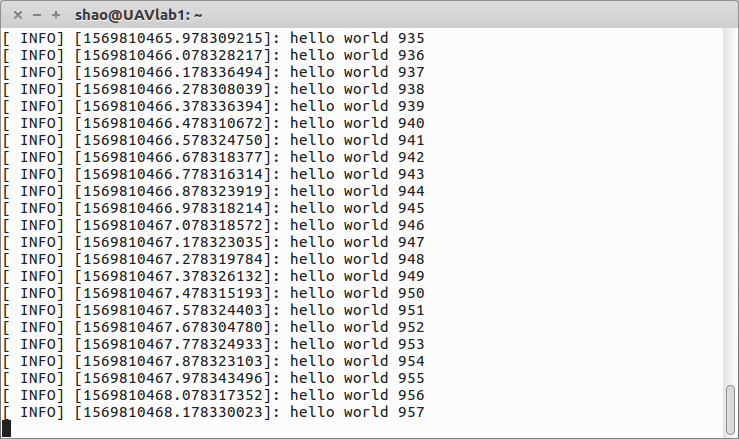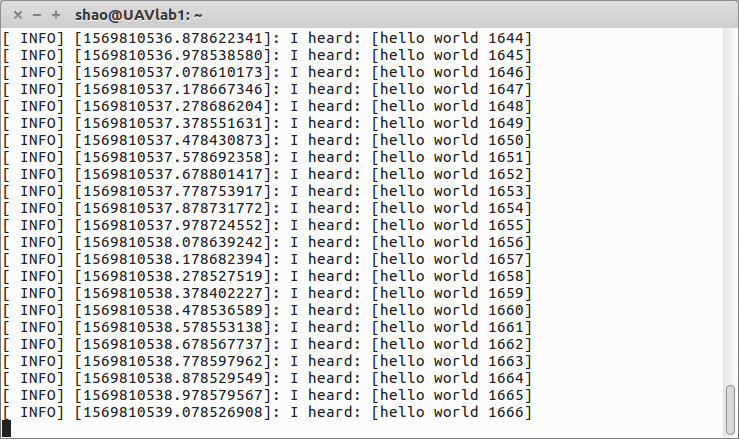本文档来源于:http://wiki.ros.org/ROS/Tutorials/WritingPublisherSubscriber%28c%2B%2B%29
- 写发布者节点
如前所述,节点是连接到ROS网络的一个可执行程序,在该例中,写一个节点名为Talker,该节点对外不断发布消息。
先转到包路径:roscd begginner_tutorials
先创建一个src目录用于存放源代码:
mkdir -p src
然后在其中创建一个talker.cpp源文件,并将如下内容粘贴其中(代码解读见其中的中文注释)。
/* * Copyright (C) 2008, Morgan Quigley and Willow Garage, Inc. * * Redistribution and use in source and binary forms, with or without * modification, are permitted provided that the following conditions are met: * * Redistributions of source code must retain the above copyright notice, * this list of conditions and the following disclaimer. * * Redistributions in binary form must reproduce the above copyright * notice, this list of conditions and the following disclaimer in the * documentation and/or other materials provided with the distribution. * * Neither the names of Stanford University or Willow Garage, Inc. nor the names of its * contributors may be used to endorse or promote products derived from * this software without specific prior written permission. * * THIS SOFTWARE IS PROVIDED BY THE COPYRIGHT HOLDERS AND CONTRIBUTORS "AS IS" * AND ANY EXPRESS OR IMPLIED WARRANTIES, INCLUDING, BUT NOT LIMITED TO, THE * IMPLIED WARRANTIES OF MERCHANTABILITY AND FITNESS FOR A PARTICULAR PURPOSE * ARE DISCLAIMED. IN NO EVENT SHALL THE COPYRIGHT OWNER OR CONTRIBUTORS BE * LIABLE FOR ANY DIRECT, INDIRECT, INCIDENTAL, SPECIAL, EXEMPLARY, OR * CONSEQUENTIAL DAMAGES (INCLUDING, BUT NOT LIMITED TO, PROCUREMENT OF * SUBSTITUTE GOODS OR SERVICES; LOSS OF USE, DATA, OR PROFITS; OR BUSINESS * INTERRUPTION) HOWEVER CAUSED AND ON ANY THEORY OF LIABILITY, WHETHER IN * CONTRACT, STRICT LIABILITY, OR TORT (INCLUDING NEGLIGENCE OR OTHERWISE) * ARISING IN ANY WAY OUT OF THE USE OF THIS SOFTWARE, EVEN IF ADVISED OF THE * POSSIBILITY OF SUCH DAMAGE. */ // %Tag(FULLTEXT)% // %Tag(ROS_HEADER)% //Comment by spy: ros/ros.h为ros系统基本功能所需的头文件 #include "ros/ros.h" // %EndTag(ROS_HEADER)% // %Tag(MSG_HEADER)% //Comment by spy: std_msgs/String.h为std_msgs包中的一个消息头文件,由String.msg文件生成 #include "std_msgs/String.h" // %EndTag(MSG_HEADER)% #include <sstream> /** * This tutorial demonstrates simple sending of messages over the ROS system. */ int main(int argc, char **argv) { /** * The ros::init() function needs to see argc and argv so that it can perform * any ROS arguments and name remapping that were provided at the command line. * For programmatic remappings you can use a different version of init() which takes * remappings directly, but for most command-line programs, passing argc and argv is * the easiest way to do it. The third argument to init() is the name of the node. * * You must call one of the versions of ros::init() before using any other * part of the ROS system. */ // %Tag(INIT)% // 初始化ROS,这允许我们通过命令行进行重命名,也在该出指定我们的节点名,该命名需要在ROS系统下面唯一的(不能重名) // 该命名不能含有斜杠(/)。 ros::init(argc, argv, "talker"); // %EndTag(INIT)% /** * NodeHandle is the main access point to communications with the ROS system. * The first NodeHandle constructed will fully initialize this node, and the last * NodeHandle destructed will close down the node. */ // %Tag(NODEHANDLE)% // 创建一个节点句柄,该句柄作为节点进程的句柄,第一次创建时实际上初始化节点,最后一个析构时会释放资源。 ros::NodeHandle n; // %EndTag(NODEHANDLE)% /** * The advertise() function is how you tell ROS that you want to * publish on a given topic name. This invokes a call to the ROS * master node, which keeps a registry of who is publishing and who * is subscribing. After this advertise() call is made, the master * node will notify anyone who is trying to subscribe to this topic name, * and they will in turn negotiate a peer-to-peer connection with this * node. advertise() returns a Publisher object which allows you to * publish messages on that topic through a call to publish(). Once * all copies of the returned Publisher object are destroyed, the topic * will be automatically unadvertised. * * The second parameter to advertise() is the size of the message queue * used for publishing messages. If messages are published more quickly * than we can send them, the number here specifies how many messages to * buffer up before throwing some away. */ // %Tag(PUBLISHER)% // 该句告诉master主控节点,我们将在chatter主题中发布std_msgs的String消息,在我们发布消息时, // 主控节点将会告知所有订阅该主题的节点,消息队列大小为1000,即在队列里有消息超过1000个之后,才会丢弃以前老的消息 ros::Publisher chatter_pub = n.advertise<std_msgs::String>("chatter", 1000); // %EndTag(PUBLISHER)% // %Tag(LOOP_RATE)% // 指定运行频率为10hz,在调用Rate::sleep()之前都会运行。 ros::Rate loop_rate(10); // %EndTag(LOOP_RATE)% /** * A count of how many messages we have sent. This is used to create * a unique string for each message. */ // %Tag(ROS_OK)% int count = 0; // 在ros::ok返回true的时候,持续运行,返回false的时候,中断,在以下情况下返回false: // 1.收到中断信号,SIGINT,键盘输入Ctrl+C会触发中断信号。 // 2.被同名节点从网络上踢出。 // 3.程序的其他部分调用了ros::shutdown()。 // 4.所有的ros::NodeHandles被销毁。 while (ros::ok()) { // %EndTag(ROS_OK)% /** * This is a message object. You stuff it with data, and then publish it. */ // %Tag(FILL_MESSAGE)% // 使用标准消息填充一个字符串。 std_msgs::String msg; std::stringstream ss; ss << "hello world " << count; msg.data = ss.str(); // %EndTag(FILL_MESSAGE)% // %Tag(ROSCONSOLE)% // ROS下的输出语句,代替std::cout标准输出。见ros信息级别小节。 ROS_INFO("%s", msg.data.c_str()); // %EndTag(ROSCONSOLE)% /** * The publish() function is how you send messages. The parameter * is the message object. The type of this object must agree with the type * given as a template parameter to the advertise<>() call, as was done * in the constructor above. */ // %Tag(PUBLISH)% // 发布消息 chatter_pub.publish(msg); // %EndTag(PUBLISH)% // 当添加一个订阅时,ros::spinOnce()会保证,你可以触发回调函数(callback),如果没有该语句,则不会触发。 // %Tag(SPINONCE)% ros::spinOnce(); // %EndTag(SPINONCE)% // %Tag(RATE_SLEEP)% // 休眠以确保10hz运行。 loop_rate.sleep(); // %EndTag(RATE_SLEEP)% ++count; } return 0; } // %EndTag(FULLTEXT)%该文件也可以在github如下路径中找到:https://raw.github.com/ros/ros_tutorials/kinetic-devel/roscpp_tutorials/talker/talker.cpp
大致步骤如下:- 初始化ros系统:
ros::init(argc, argv, "talker");
- 创建句柄和发布者:
ros::NodeHandle n; ros::Publisher chatter_pub = n.advertise<std_msgs::String>("chatter", 1000); -
指定频率循环发送。
- 初始化ros系统:
- 编写一个订阅者
同样,在包中创建一个listener.cpp,并粘贴以下代码(代码解释见代码中的中文注释):
/* * Copyright (C) 2008, Morgan Quigley and Willow Garage, Inc. * * Redistribution and use in source and binary forms, with or without * modification, are permitted provided that the following conditions are met: * * Redistributions of source code must retain the above copyright notice, * this list of conditions and the following disclaimer. * * Redistributions in binary form must reproduce the above copyright * notice, this list of conditions and the following disclaimer in the * documentation and/or other materials provided with the distribution. * * Neither the names of Stanford University or Willow Garage, Inc. nor the names of its * contributors may be used to endorse or promote products derived from * this software without specific prior written permission. * * THIS SOFTWARE IS PROVIDED BY THE COPYRIGHT HOLDERS AND CONTRIBUTORS "AS IS" * AND ANY EXPRESS OR IMPLIED WARRANTIES, INCLUDING, BUT NOT LIMITED TO, THE * IMPLIED WARRANTIES OF MERCHANTABILITY AND FITNESS FOR A PARTICULAR PURPOSE * ARE DISCLAIMED. IN NO EVENT SHALL THE COPYRIGHT OWNER OR CONTRIBUTORS BE * LIABLE FOR ANY DIRECT, INDIRECT, INCIDENTAL, SPECIAL, EXEMPLARY, OR * CONSEQUENTIAL DAMAGES (INCLUDING, BUT NOT LIMITED TO, PROCUREMENT OF * SUBSTITUTE GOODS OR SERVICES; LOSS OF USE, DATA, OR PROFITS; OR BUSINESS * INTERRUPTION) HOWEVER CAUSED AND ON ANY THEORY OF LIABILITY, WHETHER IN * CONTRACT, STRICT LIABILITY, OR TORT (INCLUDING NEGLIGENCE OR OTHERWISE) * ARISING IN ANY WAY OUT OF THE USE OF THIS SOFTWARE, EVEN IF ADVISED OF THE * POSSIBILITY OF SUCH DAMAGE. */ // %Tag(FULLTEXT)% #include "ros/ros.h" #include "std_msgs/String.h" /** * This tutorial demonstrates simple receipt of messages over the ROS system. */ // %Tag(CALLBACK)% // 接收到主题消息时的回调函数 void chatterCallback(const std_msgs::String::ConstPtr& msg) { ROS_INFO("I heard: [%s]", msg->data.c_str()); } // %EndTag(CALLBACK)% int main(int argc, char **argv) { /** * The ros::init() function needs to see argc and argv so that it can perform * any ROS arguments and name remapping that were provided at the command line. * For programmatic remappings you can use a different version of init() which takes * remappings directly, but for most command-line programs, passing argc and argv is * the easiest way to do it. The third argument to init() is the name of the node. * * You must call one of the versions of ros::init() before using any other * part of the ROS system. */ // 初始化:指定节点名称。 ros::init(argc, argv, "listener"); /** * NodeHandle is the main access point to communications with the ROS system. * The first NodeHandle constructed will fully initialize this node, and the last * NodeHandle destructed will close down the node. */ // 创建节点句柄 ros::NodeHandle n; /** * The subscribe() call is how you tell ROS that you want to receive messages * on a given topic. This invokes a call to the ROS * master node, which keeps a registry of who is publishing and who * is subscribing. Messages are passed to a callback function, here * called chatterCallback. subscribe() returns a Subscriber object that you * must hold on to until you want to unsubscribe. When all copies of the Subscriber * object go out of scope, this callback will automatically be unsubscribed from * this topic. * * The second parameter to the subscribe() function is the size of the message * queue. If messages are arriving faster than they are being processed, this * is the number of messages that will be buffered up before beginning to throw * away the oldest ones. */ // %Tag(SUBSCRIBER)% // 订阅指定主题,并指定回调函数,1000为队列大小,当我们来不及处理消息时,会存储在该队列中,若队列元素大于1000,则会抛弃老的消息 ros::Subscriber sub = n.subscribe("chatter", 1000, chatterCallback); // %EndTag(SUBSCRIBER)% /** * ros::spin() will enter a loop, pumping callbacks. With this version, all * callbacks will be called from within this thread (the main one). ros::spin() * will exit when Ctrl-C is pressed, or the node is shutdown by the master. */ // %Tag(SPIN)% // spin会进入循环,并在有消息到达时处理消息,Ctrl+C会结束该循环,或者主控节点关闭该节点时也会结束循环。 ros::spin(); // %EndTag(SPIN)% return 0; } // %EndTag(FULLTEXT)% - 编译节点
在CMakeLists.txt中加入如下代码:
add_executable(talker src/talker.cpp) target_link_libraries(talker ${catkin_LIBRARIES}) add_dependencies(talker beginner_tutorials_generate_messages_cpp) add_executable(listener src/listener.cpp) target_link_libraries(listener ${catkin_LIBRARIES}) add_dependencies(listener beginner_tutorials_generate_messages_cpp)这些代码会将上述两个节点加入编译为可执行程序,并指定所需链接库和依赖。
然后执行catkin_make,代码如下:# In your catkin workspace $ cd ~/catkin_ws $ catkin_make
编译成功显示如下:
Base path: /home/shao/catkin_ws Source space: /home/shao/catkin_ws/src Build space: /home/shao/catkin_ws/build Devel space: /home/shao/catkin_ws/devel Install space: /home/shao/catkin_ws/install #### #### Running command: "make cmake_check_build_system" in "/home/shao/catkin_ws/build" #### #### #### Running command: "make -j8 -l8" in "/home/shao/catkin_ws/build" #### [ 0%] Built target std_msgs_generate_messages_eus [ 0%] Built target std_msgs_generate_messages_lisp [ 0%] Built target std_msgs_generate_messages_nodejs [ 0%] Built target std_msgs_generate_messages_py [ 0%] Built target std_msgs_generate_messages_cpp [ 0%] Built target _begginner_tutorials_generate_messages_check_deps_AddTwoInts [ 0%] Built target _begginner_tutorials_generate_messages_check_deps_Num [ 5%] Generating EusLisp code from begginner_tutorials/Num.msg [ 11%] Generating EusLisp manifest code for begginner_tutorials [ 17%] Generating EusLisp code from begginner_tutorials/AddTwoInts.srv [ 23%] Generating Javascript code from begginner_tutorials/Num.msg [ 29%] Generating C++ code from begginner_tutorials/AddTwoInts.srv [ 35%] Generating C++ code from begginner_tutorials/Num.msg [ 41%] Generating Python from MSG begginner_tutorials/Num [ 47%] Generating Lisp code from begginner_tutorials/Num.msg [ 52%] Generating Javascript code from begginner_tutorials/AddTwoInts.srv [ 58%] Generating Lisp code from begginner_tutorials/AddTwoInts.srv [ 64%] Generating Python code from SRV begginner_tutorials/AddTwoInts [ 64%] Built target begginner_tutorials_generate_messages_nodejs [ 64%] Built target begginner_tutorials_generate_messages_lisp [ 70%] Generating Python msg __init__.py for begginner_tutorials [ 76%] Generating Python srv __init__.py for begginner_tutorials [ 76%] Built target begginner_tutorials_generate_messages_cpp [ 88%] Building CXX object begginner_tutorials/CMakeFiles/talker.dir/src/talker.cpp.o [ 88%] Building CXX object begginner_tutorials/CMakeFiles/listener.dir/src/listener.cpp.o [ 88%] Built target begginner_tutorials_generate_messages_py [ 88%] Built target begginner_tutorials_generate_messages_eus [ 88%] Built target begginner_tutorials_generate_messages [ 94%] Linking CXX executable /home/shao/catkin_ws/devel/lib/begginner_tutorials/talker [ 94%] Built target talker [100%] Linking CXX executable /home/shao/catkin_ws/devel/lib/begginner_tutorials/listener [100%] Built target listener
- 运行节点
打开一个新终端:
roscore
然后运行talker节点:
rosrun beginner_tutorials talker
出现发布信息:

运行listener节点:
rosrun beginner_tutorials listener
出现接收界面:

运行成功。好久不见,hello world。